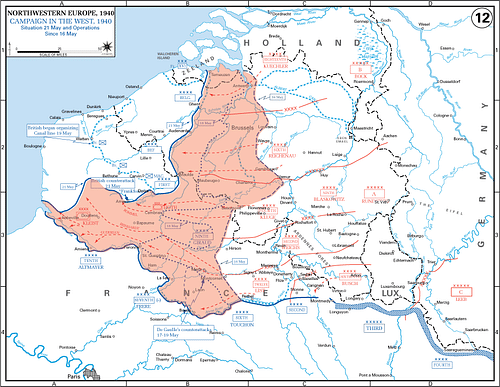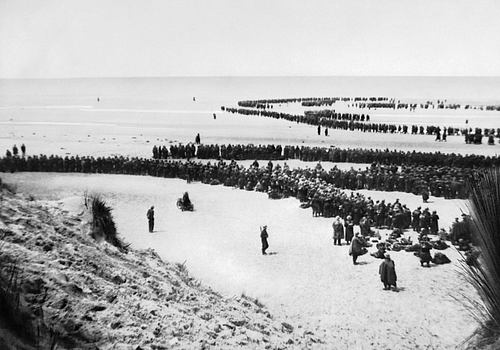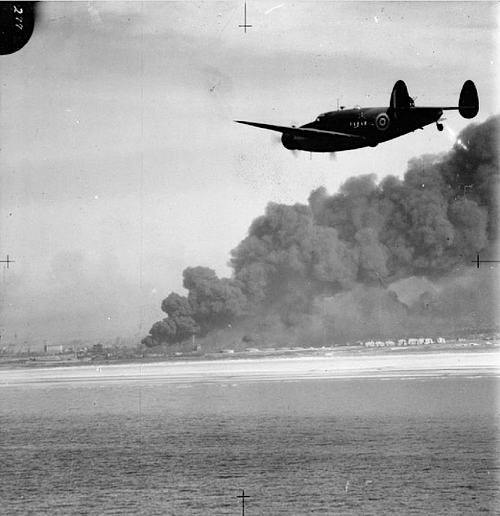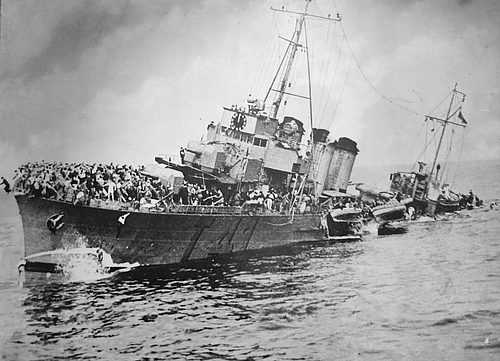
The Dunkirk Evacuation of 26 May to 4 June 1940, known as Operation Dynamo, was the attempt to save the British Expeditionary Force in France from total defeat by an advancing German army. Nearly 1,000 naval and civilian craft of all kinds, aided by calm weather and RAF air support, managed to evacuate around 340,000 British, French, and Allied soldiers.
The evacuation led to soured Franco-Anglo relations as the French considered Dunkirk a betrayal, but the alternative was very likely the capture of the entire British Expeditionary Force on the Continent. France surrendered shortly after Dunkirk, but the withdrawal allowed Britain and its empire to harbour its resources and fight on alone in what would become an ever-expanding theatre of war.
Germany's Blitzkrieg
At the outbreak of the Second World War when Germany invaded Poland on 1 September 1939, France was relying almost entirely on a single defensive line to protect itself against invasion. These defences were the Maginot Line, a series of mightily impressive concrete structures, bunkers, and underground tunnels which ran along France's eastern frontiers. Manned by 400,000 soldiers, the defence system was named after the French minister of war André Maginot. The French imagined a German attack was most likely to come in two places: the Metz and Lauter regions. As it turned out, Germany attacked France through the Ardennes and Sedan on the Belgian border, circumventing most of the Maginot Line and overrunning the inadequate French defences around the River Meuse, inadequate because the French had considered the terrain in this forested area unsuitable for tanks. Later in the campaign, the Maginot Line was breached near Colmar and Saarbrücken.
To bolster the defences of France, Britain had sent across the British Expeditionary Force (BEF) under the command of General John Vereker (better known by his later title Lord Gort, 1886-1946). Around 150,000 men, mostly infantry, had arrived in September 1939 to strengthen the Franco-Belgian border. The BEF included the British Advanced Air Striking Force of 12 RAF squadrons. The aircraft were mostly Hawker Hurricane fighters and a few light bombers, all given much to the regret of RAF commanders who would have preferred to have kept these planes for home defence. The superior Supermarine Spitfire fighters were kept safely in Britain until the very last stages of the battle in France. The BEF had no armoured divisions and so was very much a defensive force, rather than an offensive one. More infantry divisions arrived up to April 1940, so the BEF grew to almost 400,000 men, but 150,000 of these had little or no military training. As General Bernard Montgomery (1887-1976) noted, the BEF was "totally unfit to fight a first class war on the Continent" (Dear, 130). In this respect, both Britain and France were very much stuck in the defensive-thinking mode that had won them the First World War (1914-18). Their enemy was exactly the opposite and had planned meticulously for what it called Fall Gelb (Operation Yellow), the German offensive in the west.

Totally unprepared for a war of movement, the defensive-thinking French were overwhelmed in the middle weeks of May 1940 by the German Blitzkrieg ("lightning war") tactics of fast-moving tanks supported by specialist bombers and smartly followed by the infantry. German forces swept through the three neutral countries of the Netherlands, Luxembourg, and Belgium. The 9th Army punched through the Ardennes and raced in a giant curve through northeast France to reach the coast around Boulogne. The BEF and the northern French armies (7th and 1st) were cut off from the rest of the French forces to the south. Germany had achieved what it called the 'Sickle Slice' (Sichelschnitt). By 24 May, the French and British troops were isolated and with their backs to the English Channel, occupying territory from Dunkirk to Lille. Although there were sporadic counterpunches by the defenders, Gort had already concluded that the French army had collapsed as an operational force. Gort considered an attack on the Germans to the south, which he was ordered to make, would have achieved very little except the annihilation of his army. The BEF must be saved, and so he withdrew to the north.
The Dunkirk Pocket
The problem now was how to evacuate these men and bring them back to the safety of Britain. Vice Admiral Bertram Ramsey (1883-1945) came up with the idea of appealing for civilian help by providing vessels of any kind capable of crossing the English Channel and then ferrying the stranded soldiers from the Dunkirk beaches to larger ships offshore or even taking them all the way back to Dover. Vessels appealed for were to measure between 30 and 100 feet (9-30 metres).
With the German army pressing on the pocket at Dunkirk but temporarily held back by the French defence of Lille and a combined British and French force at Dunkirk, Admiral Ramsey considered that the evacuation of around 45,000 men might be possible if a big enough rescue fleet could be assembled. As it turned out, the Germans halted their advance in order to resupply their fast-moving armoured divisions and perhaps because Hitler had been convinced that the German Air Force (Luftwaffe) alone could destroy the shrinking pocket of enemy troops. The German high command had been divided on whether to advance on Dunkirk or conserve their forces for the push to Paris. General Gerd von Rundstedt (1875-1953), Commander-in-Chief of Army Group A, called the halt of German armour in the field on 24 May. General Brauchitsch, C-in-C of the German Army (1881-1948), was against such a halt, but Hitler endorsed Rundstedt's decision (both von Rundstedt and Brauchitsch were made field marshals in July). As the historian A. Gilbert notes:
The 'Halt Order' was the single great mistake made by the Germans during the 1940 campaign in the west. If the panzers had been given their head, then the Allies would have been trapped and forced to surrender, and over 200,000 of Britain's best soldiers would have been permanently lost.
(134)

Another boon for the Allied operation was the unusually calm weather in the last week of May and the first days of June. Still, the Luftwaffe and German naval forces were determined to attack the evacuation (both troops on the beach and the ships in the Channel). Even in ideal conditions, getting tens of thousands of men off a single, 10-mile-long (16 km) beach was a monumental logistics task.
The Volunteer Armada
Somewhere between 850 and 950 vessels of all kinds were involved in the Dunkirk evacuation, which ran from 26 May to 4 June. There were tug boats, fishing boats (British, French, and Belgian), lifeboats, barges (including Dutch ones), ferry boats, and pleasure craft of all descriptions. Ramsey coordinated the volunteer effort from a base in the cliffs of Dover. Ramsey's operations room had once housed a dynamo, and this gave the evacuation its official name: Operation Dynamo. The armada of 'little ships' was coordinated by Admiral Wake-Walker (1888-1945).
39 Royal Navy destroyers played a key role in evacuating the personnel from Dunkirk, taking on board men ferried to them by smaller vessels that could get close to the beach. Lieutenant Commander John McBeath, commander of the destroyer HMS Venomous gives the following description of the Dunkirk rescue fleet:
The powers-that-be back in the UK got this small-boat flotilla organisation going. It started in a rather haphazard way because all sorts of boats varying from little tiny family motorboats to much larger club boats and in fact almost everything that could steam across to the other side were operating it at first, rather on their own. Some of them never made it and a lot of them went to the wrong places, but eventually they got it channelled and then one came across lots of these little boats going to and fro, many of them with a dozen or so soldiers on board.
(Holmes, 109)

Bertie Good, the chief steward of Royal Daffodil, a civilian ferry involved in the evacuation, gives the following account:
We arrived off Gravelines and were attacked by German aircraft…We went on into Dunkirk…George Johnson took us in and we tied up alongside and the troops came up out of the ground, like a lot of rats, and they just ran to the ship. We took seventeen hundred men on board and just when we were picking the gangway up about thirty or forty ambulances came down the pier…So the ship's crew went ashore and brought every man out of the ambulances [six men from each] and put them in the after dining room. None of these chaps had had their wounds dressed, they were in a hell of a state. All the officers in the ship who had first-aid kits started to dress their wounds.
(Holmes, 108)
On its thirteenth trip to Dunkirk, the Royal Daffodil was hit by a bomb from a German aircraft. The ferry survived, but a crewman was killed, and five were wounded by machine gun fire from the attacker. Some of the craft crossing the channel were also subjected to submarine and E-boat attacks, and, when they approached the French coast, from enemy artillery shells. The ever-shrinking pocket around Dunkirk came under intense pressure from three directions, a pressure that only intensified following the remobilisation of the German tank divisions on 27 May and the surrender of Belgium on 28 May. The BEF was fighting a brutal rearguard action to win a few more days for the ongoing evacuation, which had so far only managed to save a paltry 8,000 men. A much faster rate of evacuation was achieved from 28 May by using the east mole of Dunkirk's harbour. The staunch French defence of Lille was also helping divert German resources that would otherwise have been mobilised to Dunkirk.

The RAF stepped up its involvement in the final days of the evacuation, but the British-based fighters were flying at the very limit of their fuel range. The Luftwaffe continued to bomb Dunkirk, destroying the town, its railway yards, docks, and the nearby oil refineries at St. Pol. Squadron Leader Max Aitken had a bird's view of the shore:
Dunkirk was a shambles: there was a huge pall of smoke which came from burning ships and burning oil installations, and aircraft were flying in this smoke…We'd have occasional dogfights but it was very confusing. The weather was absolutely glorious – you could see for miles except for the smoke and the smoke was fantastic. We did not try to protect the troops over the beaches; that wasn't our job. Our job was to stop any aircraft getting to those troops.
(Holmes, 109)
Besides the chaos in the skies and open waters, there was self-inflicted confusion on the beaches, too. Many soldiers were so eager to get out that they risked overloading the boats. Most troops had been on the beaches for days without food or water, many were almost too weak to walk or swim, and so, inevitably, drownings were common. Queues were formed from the beaches out into the sea where it was shallow enough to stand but deep enough for small craft to approach. Some smaller boats deliberately grounded themselves on the beach to give the weaker men a chance to board or to provide a pier to another boat. The sea was becoming full of boats wrecked by bombs and dead bodies, hampering the approach of new waves of boats, which ran the gauntlet of shells from the land, bombs from the air, and mines in the sea. As one cockney soldier remarked in summary of the whole operation just as he was fished out of the sea and into the safety of a rescue boat: "Gawd, what a bloody nightmare!" (Liddle Hart, 46).
The British and French commanders were also guilty of contributing to the general confusion via several miscommunications and misunderstandings. At first, the British had the idea that their own troops would be evacuated while the French remained as a rearguard defence. At the same time, the French army commanders were hesitating over whether or not they should even allow French troops to be evacuated. It was only in the last two days of the operation, when most of the British had gone, that a concerted effort was made to evacuate French troops as well.

Reckoning
In the end, around 220,000 British and 120,000 French soldiers were evacuated from Dunkirk. The Admiralty figure for the total number evacuated from Dunkirk was 338,226. This was an extraordinary escape, and it allowed Britain to continue the war. As Prime Minister Winston Churchill (1874-1965) noted on 4 June, "there was a victory inside this deliverance" (Dear, 243). There had been, though, tremendous losses.
During the German advance, the BEF had lost 68,111 men in action (killed, wounded, or taken prisoner) and another 600 in accidental deaths. The Dutch had lost nearly 3,000 men with another 7,000 wounded. 7,500 Belgian troops had been killed and 15,850 wounded. 30,000 French troops were left at Dunkirk to face their fate. Nine Allied destroyers, various other naval craft, and around 200 civilian vessels of all kinds were lost to bombs, torpedoes, shells, and mines. The destroyer HMS Wakeful was torpedoed, and 600 soldiers drowned. 19 destroyers were damaged but not sunk. The RAF had desperately tried to protect the evacuation fleet, but 106 vital fighter planes were lost in the operation. In total, the RAF had lost 931 aircraft and suffered over 1,500 casualties in the defence of France, including the loss of over 500 pilots. All the BEF's transportation and heavy equipment were lost; not only valuable artillery (nearly 2,500 pieces) but also essential items like fuel trucks (RAF airfields back in Britain would feel their loss for some time). In total, nearly 64,000 vehicles were lost. 500,000 tons of ammunition and stores were abandoned. A great escape it might have been, but as Churchill succinctly reminded the British Parliament, "Wars are not won by evacuations" (Gilbert, 139).
There were other evacuations of British (and Polish and other Allied) troops from France after Dunkirk, notably at Le Havre, Veules-les-Roses, and St. Nazaire, which included the sinking of the Lancastria troopship, where 3,000 men died. Overall, the sentiment in Britain, as Churchill had expressed, was that a defeat had turned into a victory, or at least a victory of morale. The vast volunteer fleet that had sailed the Channel in those hectic days of May and June of 1940 and which had involved people of all types and nationalities, became the stuff of legend. The 'Dunkirk Spirit', as it was called, would help inspire the British through the troubled times ahead.
The Defence of Britain
From 5 June, the German army swept southwards right across France from Nantes to Besançon; Paris was captured on 14 June. The French government moved to Bordeaux and surrendered on 22 June. The Fall of France had taken just six weeks. Anxious that the French Navy, then stationed in North Africa, did not fall into German hands, Churchill requested the French ships sail to Britain or take refuge in neutral ports. The French rejected this idea, and so the RAF bombed the fleet in July, resulting in 1,600 deaths.
The relatively small size of Britain's military aid to the defence of France and the evacuation at Dunkirk and its immediate aftermath, such as the naval bombing, all seriously soured Anglo-French relations. In any case, badly battered Britain had lost its chief ally, and though it could call on troops from its empire, it was now on its own against Germany and Italy (which entered the war on 10 June). The British, and particularly the RAF, had to quickly regroup and prepare for what then seemed an imminent German invasion, an attack that would be preceded by a bombing campaign of airfields and aircraft factories in an attempt to achieve air superiority for the Luftwaffe. The Battle of Britain was to be the next crucial phase of the war in Europe.






